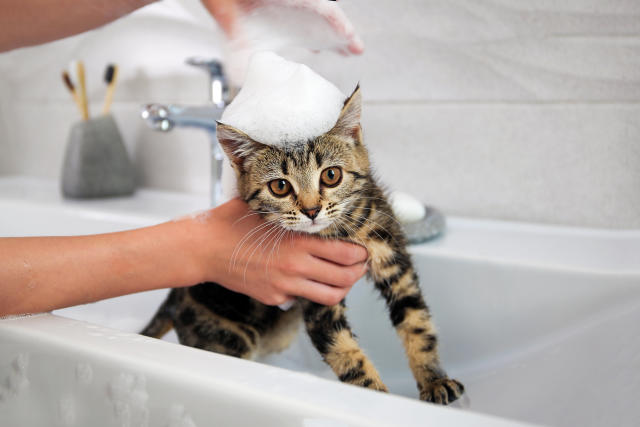Cats are known for being fastidious self-groomers, and many of them dislike being bathed. Unlike dogs, who are often more tolerant of water and bathing, most cats will try to avoid it at all costs. However, there are times when a bath becomes necessary, whether it’s due to a medical condition, an outdoor adventure that led to a dirty coat, or an accidental mess.
If your cat doesn’t like baths, don’t worry—it’s a common issue! The key is to approach the process with patience, care, and the right technique. In this article, we’ll explore how to bathe a cat effectively, reduce their stress, and ensure the process is as safe and pleasant as possible for both of you.
Why Do Cats Dislike Bathing?
Understanding why your cat may not enjoy bathing can help you empathize with their behavior and approach the situation calmly. Here are some common reasons cats dislike baths:
- Instinctual Aversion to Water: Cats have an inherent fear of water. Their fur is naturally designed to repel moisture, and getting wet can make them feel vulnerable.
- Loss of Control: Cats like to feel in control of their environment. Being placed in a bathtub or sink and subjected to water can make them feel trapped and powerless.
- Stress and Anxiety: The noise, the unfamiliar sensations of being submerged in water, and the handling can cause stress for your cat. This often results in them scratching, trying to escape, or becoming anxious.
- Past Negative Experiences: If your cat has had a negative experience with bathing in the past, they may associate it with fear and discomfort. This can make future bath time even more challenging.
When Is It Necessary to Bathe a Cat?
Before diving into the “how,” it’s important to understand when a bath is necessary. Cats usually do a fantastic job of grooming themselves, so frequent bathing is rarely required. However, there are certain circumstances where a bath may be necessary:
- Medical Reasons: Cats with skin conditions (such as flea infestations, fungal infections, or dermatitis) may require medicated baths.
- Injury or Mess: If your cat has gotten into something sticky, oily, or toxic, a bath is needed to clean them up safely.
- Long-Haired Cats: Cats with long hair (like Persians or Maine Coons) may require occasional bathing to prevent mats and tangles.
- Odor Removal: If your cat smells particularly bad (perhaps after rolling in something unpleasant), a bath can help eliminate the odor.
- Overweight or Elderly Cats: Older or obese cats might not groom themselves as thoroughly as they should, and an occasional bath can help keep their coat and skin healthy.
If none of these conditions apply and your cat is grooming well, it’s usually best to skip regular baths and let them do what they do best—self-groom!
How to Prepare for Bathing a Cat
Proper preparation is essential to ensure that the bathing experience goes as smoothly as possible. Here’s how to get ready:
1. Gather Supplies
Make sure you have everything you need before starting the bath, as you don’t want to leave your cat unattended while you scramble to find something.
- Cat-Specific Shampoo: Use a gentle, cat-safe shampoo. Avoid using human shampoo or products meant for dogs, as these can irritate a cat’s sensitive skin.
- Towel: Have a towel ready to dry your cat after the bath.
- Cup or Small Showerhead: A cup or gentle showerhead is useful for pouring water over your cat. A spray nozzle might be too intense and could frighten them.
- Non-Slip Mat: Placing a non-slip mat in the bathtub or sink will help your cat feel more secure and prevent them from slipping.
- Brush: Brush your cat’s fur beforehand to remove tangles and mats. Brushing can also help reduce stress and help them feel calmer.
- Treats and Praise: Have your cat’s favorite treats nearby to reward them after the bath. Positive reinforcement is key to making bath time a less stressful experience.
2. Choose the Right Location
Choose a location where your cat will feel secure. Many people use a sink or a bathtub, depending on their cat’s size and temperament.
- Sink: If your cat is small or you’re just giving them a quick bath, a sink can work well. It’s less intimidating than a large tub and offers easier access for you.
- Bathtub or Shower: For larger cats, the bathtub or shower may be more appropriate, but it’s a good idea to use a non-slip mat and to make sure the water is shallow enough not to overwhelm your cat.
3. Prepare the Water
Ensure that the water temperature is lukewarm, not too hot or cold. Test it with your wrist to make sure it’s comfortable. Too hot water can burn your cat, while cold water may cause them to become even more stressed.
Step-by-Step Guide to Bathing Your Cat
Now that you’re prepared, it’s time to bathe your cat. Here’s a step-by-step guide to make the process as smooth as possible:
Step 1: Calm Your Cat
Before you even get near the water, make sure your cat is calm. Some cats may get anxious if they sense something is up. Speak to them in a calm, soothing voice, and pet them gently. This will help reduce their anxiety.
- Use Feline Pheromones: If your cat is particularly stressed, consider using a calming spray with synthetic feline pheromones (like Feliway) to help soothe them.
Step 2: Gently Place Your Cat in the Water
If your cat is not used to baths, do not force them into the water. Instead, gently place them in the tub or sink. Make sure their paws are on a non-slip surface to prevent slipping, which could cause them to panic.
- Gradual Introduction: You can introduce them to the water slowly by pouring a little water on their paws or legs first. This helps them get accustomed to the sensation of water before they’re fully submerged.
- Stay Calm and Steady: Hold your cat gently but firmly so they don’t panic and try to escape. Cats often feel safer when they know they’re supported, but don’t squeeze too tightly.
Step 3: Wet Your Cat
Using a cup or a gentle showerhead, slowly wet your cat’s fur, starting from their back and working your way down. Avoid getting water directly in their face, ears, or eyes. Keep the water level low, as cats often feel overwhelmed if submerged too deeply.
- Keep Water Out of Their Face: Cats can get very stressed if water touches their face or ears. Use a damp washcloth to wipe their face gently instead of pouring water directly onto it.
Step 4: Apply Shampoo
Once your cat’s fur is wet, apply a small amount of cat-safe shampoo. Lather it up gently, starting at the neck and moving downward. Be careful around sensitive areas like the face, ears, and belly.
- Massage Gently: Massage the shampoo into their coat using gentle motions. Try to keep the experience calm and soothing, as this will reduce their anxiety.
Step 5: Rinse Thoroughly
Rinse the shampoo out of your cat’s fur thoroughly, making sure no residue is left behind. Leaving shampoo in the fur can cause irritation, so be patient and ensure their coat is completely clean.
Step 6: Dry Your Cat
After the bath, wrap your cat in a towel and gently pat them dry. Cats don’t like being wet, so try to avoid rubbing too hard, which can cause stress. Instead, gently blot their fur, especially if they have longer hair, to remove excess moisture.
- Use a Hair Dryer (Optional): If your cat tolerates it, you can use a hair dryer on a low, cool setting to dry them further. However, most cats dislike the noise and vibration of a hair dryer, so this step is optional.
Step 7: Reward Your Cat
After the bath, give your cat a treat and plenty of praise for being brave. This positive reinforcement will help them associate the experience with something pleasant.

Tips for Making Bath Time Less Stressful
- Keep It Short: Try to keep the bath time as brief as possible to minimize your cat’s stress. Cats often get anxious when they’re in the water for too long.
- Stay Calm: Cats are sensitive to your energy, so remain calm and patient throughout the process. If you’re anxious, your cat will pick up on it.
- Consider Professional Grooming: If your cat absolutely cannot tolerate baths or if they have complex grooming needs, consider taking them to a professional groomer who has experience with bathing cats.
When Should You Avoid Bathing Your Cat?
In some cases, it’s better not to bathe your cat. If your cat is sick, elderly, or recovering from surgery, bathing may cause unnecessary stress. Always consult with your vet if you’re unsure whether your cat should have a bath under specific circumstances.
Conclusion
Bathing a cat that dislikes water is undoubtedly a challenge, but with the right preparation, patience, and technique, it’s possible to make the experience less stressful for both you and your cat. By following these steps and remaining calm, your cat will eventually get used to the process—and even if they don’t come to love bath time, they’ll learn to tolerate it for the sake of their health and cleanliness. And remember, always reward your cat with treats and affection after bath time—this helps them associate the experience with positive outcomes.























































